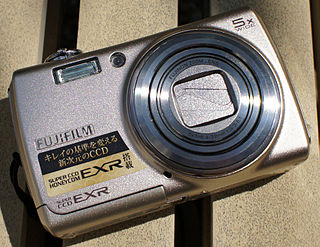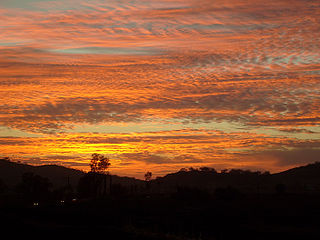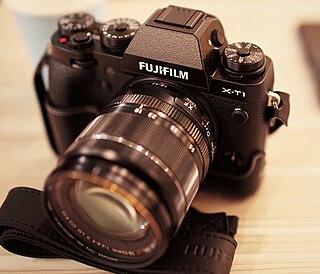
In cryptozoology and ufology, "rods" are elongated visual artifacts appearing in photographic images and video recordings.

A single-lens reflex camera (SLR) is a camera that typically uses a mirror and prism system that permits the photographer to view through the lens and see exactly what will be captured. With twin lens reflex and rangefinder cameras, the viewed image could be significantly different from the final image. When the shutter button is pressed on most SLRs, the mirror flips out of the light path, allowing light to pass through to the light receptor and the image to be captured.

A camera is an optical instrument that captures a visual image. At a basic level, cameras consist of sealed boxes, with a small hole that allows light through to capture an image on a light-sensitive surface. Cameras have various mechanisms to control how the light falls onto the light-sensitive surface. Lenses focus the light entering the camera. The aperture can be narrowed or widened. A shutter mechanism determines the amount of time the photosensitive surface is exposed to light.

A digital camera is a camera that captures photographs in digital memory. Most cameras produced today are digital, largely replacing those that capture images on photographic film. Digital cameras are now widely incorporated into mobile devices like smartphones with the same or more capabilities and features of dedicated cameras. While there are still dedicated digital cameras, many more cameras are now incorporated into mobile devices like smartphones. High-end, high-definition dedicated cameras are still commonly used by professionals and those who desire to take higher-quality photographs.

Underwater photography is the process of taking photographs while under water. It is usually done while scuba diving, but can be done while diving on surface supply, snorkeling, swimming, from a submersible or remotely operated underwater vehicle, or from automated cameras lowered from the surface.

In physics, backscatter is the reflection of waves, particles, or signals back to the direction from which they came. It is usually a diffuse reflection due to scattering, as opposed to specular reflection as from a mirror, although specular backscattering can occur at normal incidence with a surface. Backscattering has important applications in astronomy, photography, and medical ultrasonography. The opposite effect is forward scatter, e.g. when a translucent material like a cloud diffuses sunlight, giving soft light.

A point-and-shoot camera, also known as a compact camera and sometimes abbreviated to P&S, is a still camera designed primarily for simple operation. Most use focus free lenses or autofocus for focusing, automatic systems for setting the exposure options, and have flash units built in. They are popular for vernacular photography by people who do not consider themselves photographers but want easy-to-use cameras for snapshots of vacations, parties, reunions and other events.

A digital single-lens reflex camera is a digital camera that combines the optics and the mechanisms of a single-lens reflex camera with a digital imaging sensor.

Spirit photography is a type of photography whose primary goal is to capture images of ghosts and other spiritual entities, especially in ghost hunting. It dates back to the late 19th century. The end of the American Civil War and the mid-19th Century Spiritualism movement contributed greatly to the popularity of spirit photography. Photographers such as William Mumler and William Hope ran thriving businesses taking photos of people with their supposed dead relatives. Both were shown to be frauds, but "true believers", such as Sir Arthur Conan Doyle, refused to accept the evidence as proof of a hoax.

The Fujifilm FinePix F series is a line of compact digital cameras that was known for its low-light performance in 2005, with relatively low image noise and natural colors even at high ISO settings. With its relatively large, but moderate resolution Super CCD sensors, it concentrated on image quality, and low-light shooting without flash, which was mostly restricted to prosumer models at the time.

Ultraviolet photography is a photographic process of recording images by using radiation from the ultraviolet (UV) spectrum only. Images taken with ultraviolet radiation serve a number of scientific, medical or artistic purposes. Images may reveal deterioration of art works or structures not apparent under light. Diagnostic medical images may be used to detect certain skin disorders or as evidence of injury. Some animals, particularly insects, use ultraviolet wavelengths for vision; ultraviolet photography can help investigate the markings of plants that attract insects, while invisible to the unaided human eye. Ultraviolet photography of archaeological sites may reveal artifacts or traffic patterns not otherwise visible.

Ghost hunting is the process of investigating locations that are reported to be haunted by ghosts. Typically, a ghost-hunting team will attempt to collect evidence supporting the existence of paranormal activity. Ghost hunters use a variety of electronic devices, including EMF meters, digital thermometers, both handheld and static digital video cameras, including thermographic and night vision cameras, night vision goggles, as well as digital audio recorders. Other more traditional techniques are also used, such as conducting interviews and researching the history of allegedly haunted sites. Ghost hunters may also refer to themselves as "paranormal investigators."
The following outline is provided as an overview of and topical guide to photography:

The Sigma SD14 is a digital single-lens reflex camera produced by the Sigma Corporation of Japan. It is fitted with a Sigma SA mount which takes Sigma SA lenses.

Visual artifacts are anomalies apparent during visual representation as in digital graphics and other forms of imagery, especially photography and microscopy.

The Fujifilm FinePix products are a line of digital cameras produced by Fujifilm. They include compact point and shoot models, tough, waterproof models, bridge digital cameras, digital SLRs and mirrorless cameras. Many use Fujifilm's proprietary Super CCD technology sensors and CMOS sensors for high-end models.

Atmospheric optics is "the study of the optical characteristics of the atmosphere or products of atmospheric processes .... [including] temporal and spatial resolutions beyond those discernible with the naked eye". Meteorological optics is "that part of atmospheric optics concerned with the study of patterns observable with the naked eye". Nevertheless, the two terms are sometimes used interchangeably.

The Fujifilm X series is a line of digital cameras produced by Fujifilm. The series encompasses fixed lens and interchangeable lens mirrorless cameras and premium compact point-and-shoot cameras aimed at consumer, enthusiast and professional photographers. The X series is part of the larger FinePix range of digital cameras from Fujifilm.

The Fujifilm X-T1 is a weather-resistant mirrorless interchangeable lens camera announced by Fujifilm on January 28, 2014. It uses the Fujifilm X-mount and is the first entry in the X-T lineage of DSLR-styled X series cameras.

The Fujifilm X10 is a 2/3 sensor digital compact camera announced by Fujifilm on September 1, 2011. At the time of its release, it competed most closely with the Panasonic Lumix DMC-LX5, Olympus XZ-1, Canon PowerShot G1 X and Sony Cyber-shot DSC-RX100, and was subsequently named a 2013 iF product design award recipient.























